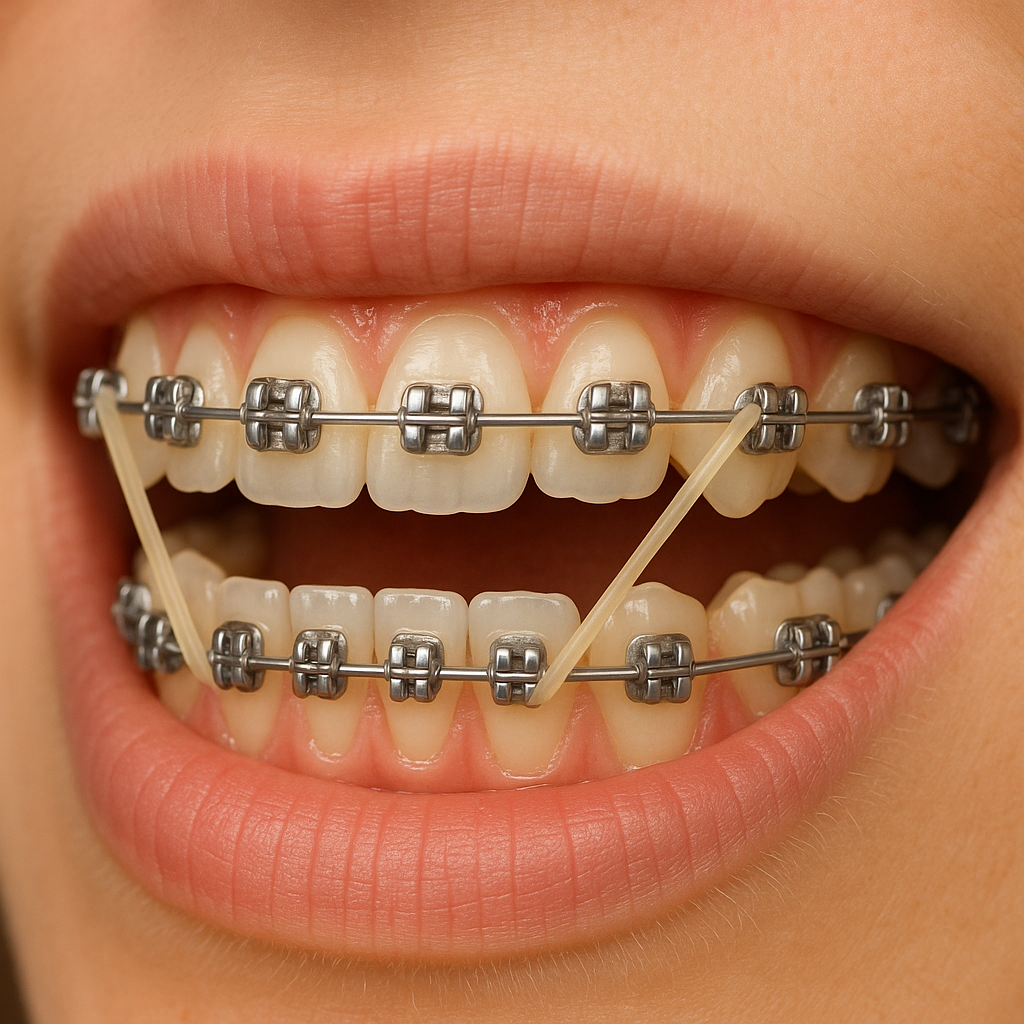Orthodontic elastics—often called rubber bands—are small, single-use loops that connect hooks on braces or clear-aligner buttons to help move teeth and correct the bite. Unlike archwires (which align teeth within a single arch), elastics apply interarch forces (upper to lower) to treat Class II/Class III relationships, vertical discrepancies (open bite), crossbites, and to fine-tune finishing.
What Do Elastics Do?
- Shift jaws/arches: Pull upper and lower teeth in planned directions (Class II/III).
- Close/open vertical spaces: Triangle or box configurations aid open-bite/overbite control.
- Stabilize finishing: Precise detailing late in treatment.
Sizes & Forces (What Those Numbers Mean)
Elastics are specified by diameter (size) and force (tension). Diameter affects how far an elastic must stretch between hooks; force indicates pull at a given stretch.
Common Diameters (inches)
1/8" (3.2 mm) – very short reach; vertical elastics, tight triangles
3/16" (4.8 mm) – short reach; vertical, early Class II/III on close hooks
1/4" (6.4 mm) – standard reach; widely used for Class II/III
5/16" (7.9 mm) – longer reach; triangles/boxes when hooks are farther apart
3/8" (9.5 mm) – long reach; posterior crossbite or distal mechanics
1/2" (12.7 mm) – extra long; special mechanics and temporary setups
Tip: Diameter ≠ strength. You can have a 1/4" elastic in light or heavy force.
Typical Force Ratings (per elastic at standard extension)
- Light: ~2–3.5 oz (≈ 60–100 g)
- Medium: ~4–4.5 oz (≈ 115–130 g)
- Heavy: ~6 oz (≈ 170 g)
- Extra-Heavy: ~6.5–8 oz (≈ 185–225 g)
Force labels vary by brand. Always check the bag’s printed force/diameter.
How Orthodontists Choose Size & Force
- Distance between hooks: Longer spans need larger diameters.
- Desired movement: Heavier forces for AP correction; lighter for stabilization or sensitive periodontal support.
- Patient tolerance & wear time: Consistency beats intensity—many doctors prefer moderate forces worn full-time.
- Elastic geometry:
- Class II: Upper canine to lower molar (often 1/4"–5/16", medium–heavy).
- Class III: Lower canine to upper molar (similar sizes/forces, reversed).
- Vertical triangles/boxes: Shorter diameters (1/8"–3/16"), light–medium.
- Crossbite: Longer diameters (5/16"–3/8"), force per plan.
Latex vs. Latex-Free
- Latex elastics: High elasticity, smooth feel, cost-effective.
- Latex-free (synthetic): For patients with latex allergy/sensitivity; slightly different stretch/force decay.
If there’s any latex concern, request latex-free elastics and confirm with your orthodontist.
Wear Schedule: The #1 Success Factor
- Full-time wear: Usually 20–22 hours/day unless told otherwise.
- Change frequently: 3–4×/day (or at least morning + night). Fresh elastics keep force consistent.
- Remove to eat/brush unless instructed to wear through meals.
- Always carry spares and replace immediately if one snaps.
Comfort, Care & Safety
- Soreness is normal for 2–3 days after starting or changing force. OTC pain relief as advised by your doctor.
- Storage: Keep in a cool, dry place; heat and light degrade elastics.
- Hygiene: Replace if food-soiled; never reuse.
- Hooks & cheeks: Use orthodontic wax if a hook irritates tissue.
- Latex allergy: Report immediately—switch to latex-free.
Troubleshooting
- Elastics pop or break often: You may be overstretching (diameter too small) or the force is too high—ask your orthodontist.
- No progress on time: Inconsistent wear is the most common reason. Log daily hours or use app reminders.
- Jaw/joint discomfort: Report persistent pain—your setup may need modification.
FAQs
How fast do elastics work?
Some changes show in 2–4 weeks with excellent compliance; full correction takes longer and varies by case.
Can I double up to go faster?
No—overloading can cause unwanted movement or root issues. Only change forces if your orthodontist says so.
Which size is “best”?
There isn’t a universal best—the right size = correct diameter for your hook distance + the prescribed force for your movement.
Quick Reference Chart (General, varies by doctor/brand)
| Goal | Common Setups | Typical Diameter | Typical Force |
|---|---|---|---|
| Class II correction | Upper canine → lower molar | 1/4"–5/16" | Medium–Heavy (4–6 oz) |
| Class III correction | Lower canine → upper molar | 1/4"–5/16" | Medium–Heavy (4–6 oz) |
| Vertical triangles | Canine–premolar–molar triangles | 1/8"–3/16" | Light–Medium (2–4.5 oz) |
| Crossbite | Buccal to lingual hooks | 5/16"–3/8" | Medium (4–4.5 oz) |
| Finishing/detailing | Targeted short spans | 1/8"–1/4" | Light–Medium (2–4.5 oz) |

